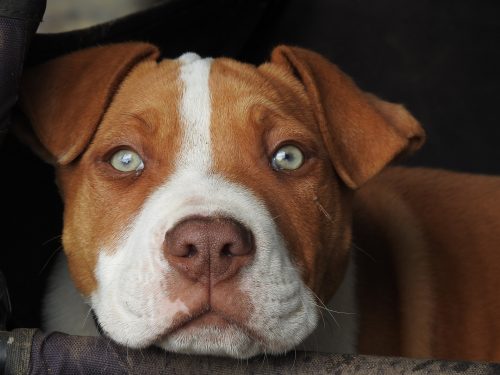You notice your dog’s eyes seem to be watering a little more than normal. You shrug it off, thinking it’s probably just allergies and will resolve itself in a couple of days. You go about your business.
The next day, your dog suddenly has something red popping out of his eye!
Relax! No stress and anxiety is necessary. This is actually a fairly common condition with dogs’ eyes involving a prolapsed gland of the third eyelid, or nictitating membrane. Otherwise known as “Cherry Eye”.
When your dog has Cherry Eye, you will see a protrusion of pink tissue that appears to be coming out of the corner of your dog’s eyelid. It is attached there with a fibrous material that becomes weakened. This condition is seen most often in younger dogs as well as smaller dog breeds.
Though Cherry Eye in dogs is not life-threatening or even particularly dangerous, it can be uncomfortable for your canine if left untreated. It can also lead to more serious secondary heath concerns.
The longer the gland of the third eyelid remains out of place and exposed, the higher the risk of inflammation, irritation, and potential eye infections your dog will face. Any of the three can endanger the future health of your dog’s eyes, so it’s important treat the prolapsed gland as soon as possible.
Symptoms of Cherry Eye in Dogs

Cherry Eye is a condition that can manifest and progress very quickly, and symptoms are strongly tied to what stage it is in. The nictitating membrane and attached tear glands do not move out of place slowly. They tend to do so quickly, often suddenly, which is what causes the tear gland to protrude in the first place.
Your dog’s eye could seem completely normal one moment, and then suddenly present with a pink and protruding mass from inside the lower corner of his eye in the next moment.
The mass is typically well-defined and solitary, and you may notice the bulge coming from one eye or both eyes. Often, the protrusions are the only symptoms your dog will present with to alert you to his condition.
The third eyelid gland works by making the fluid that creates a film of tears over the eye. The primary function of this fluid is to protect the eye, especially the cornea.
When a dog is afflicted with Cherry Eye, the tear gland and nictitating membrane aren’t where they are supposed to be. This causes your dog’s eyes to suffer. The eyeball can become dry and irritated, as well as red and inflamed. Sometimes your dog may present with an abnormal discharge that leaks from his eyes.
Unfortunately, some dogs will rub their eyes in annoyance, pawing and scratching at them. These behaviors only serve to cause further damage.
If your dog rubs his eye and the protrusion is exposed to further pollutant and irritants, things can progress quickly and get worse. If left untreated, your dog can develop secondary infections and inflammation that can be detrimental to his vision and the overall health of his eyes, and you may notice the area that looked red and swollen before, is now starting to look black in color and could even appear to be rotting.
Most Common Signs of Cherry Eye to Look for Are:
- Impaired vision
- Squinting
- Pawing or rubbing at his eyes
- Conjunctivitis or eye redness
- Swelling in the eye area
- Pus-filled discharge
- “Eye rot” and changes to a black color
- Dry eyes, which means insufficient tear production
- Eye drainage, which means an excessive production of tears
Causes of Cherry Eye in Dogs
Cherry Eye is not a condition that is understood well. Every dog has what is known as the third eyelid, which is just beneath the lower eyelid and typically is invisible. These invisible eyelids contain tear glands that are used to lubricate the eyes, and are held to the globe of the eye by a fibrous tissue.
If these fibrous tissues get weak for any reason, it can cause what’s known as a prolapsed tear gland, or sometimes called a bulging tear gland. These tear glands will bulge around or over the third eyelid, presenting as a pink or red looking protrusion of tissue.
Dogs can develop Cherry Eye in one eye or both eyes. Usually if a dog gets it in one eye, even if the other eye doesn’t have a problem at first, it can happen later down the road. It is thought that genetics play a role, related to the fibrous tissue that connects with the third eyelid. The theory is that certain dog breeds could be more prone to weakened connective tissue than others.
Inflammation in response to damage or injury can also cause Cherry Eye. Sometimes it is caused by tissue hypertrophy. Tissue hypertrophy is an enlargement of the existing cells in a dog’s third eyelid not triggered by cell growth.
Sometimes Cherry Eye in dogs can correct on its own, however, is not recommended to wait in seeking treatment. The longer your dog suffers from Cherry Eye and the longer the gland stays out of place, the more inflammation and swelling that will occur.
Not only does this make it harder to reposition and treat the condition successfully, it makes the chances of the protrusion happening again much higher.
Other Suspected Causes of Cherry Eye in Dogs:
- Bacterial infections
- A parasite
- Fungal infections
- Cancer
- Dermatitis
- Sun damage
- A compromised immune system
Unfortunately, because this condition tends to be hereditary, it’s not recommended to breed dogs who have had a bout with Cherry Eye, because it will most likely be passed on to his offspring.
Dogs at Most Risk for Developing Cherry Eye
Dogs that are most susceptible to Cherry Eye are usually younger dogs. Often, they will be two years of age or less. It also appears to be more common in smaller dogs, and there are certain breeds that appear to be predisposed to the condition.
Dog Breeds Thought to Be Genetically Predisposed to Cherry Eye:

Brachycephalic dogs with short, flat faces and wide heads also appear to be predisposed. If you see any abnormal protrusions from your dog’s eye, in order to prevent any permanent ocular damage, you should see your veterinarian as soon as possible.
Diagnosing Cherry Eye in Dogs
In most cases, it will be very evident when a dog has Cherry eye. It is hard to miss protruding red or pink tissue! Which is good, because the sooner this condition is treated, the better, to avoid additional ocular complications.
There are not usually any complicated procedures that are used to diagnose Cherry Eye, a physical exam by your vet should be sufficient. The nature of this disorder means it comes on suddenly, with very visible symptoms that are difficult to overlook.
However, if your dog develops similar masses of tissue in one or both eyes over a long period of time, and the onset is not sudden, then there could be cause for concern. Unfortunately, a slow onset means that the more likely scenario is cancer rather than Cherry Eye.
Treating Cherry Eye in Dogs
There are a variety of treatment options for Cherry Eye. The goal of all treatment is to reposition the tear gland in the proper place that it belongs, and to return the state of your dog’s eye to normal. Ideally, this will be achieved with no vision loss or impairment.
Other Goals of Cherry Eye Treatment Are:
- To eliminate any pain or discomfort
- To reduce abnormal discharging and leaking
- To minimize any corneal and conjunctival tissue injury
- To minimize ocular irritation
- To promote the production of tears
- To reduce the risks of canine eye infection
Sometimes Cherry Eye Syndrome may be treated with a topical antibiotic ointment, as well as anti-inflammatories and surgical options. However, it should be noted that topical therapies do not correct Cherry Eye. While these treatments can reduce inflammation, and lower your dog’s chances of developing a secondary infection, unfortunately, without a surgical procedure to replace the tear gland in its proper location, Cherry Eye cannot be corrected.
Sometimes, if it’s in early stages, or the case is mild, massage can be helpful in manipulating the gland back into its proper place. However, this is not always the case, either because the condition is already too advanced, or because there are additional complications that massage therapy would be unable to improve upon.

With surgery, your vet will typically put your dog under local anesthesia, and then will remove a small portion of the tear gland. They will then reposition and tuck the remaining gland and tissue back in its proper placement.
It was once recommended to remove the third eyelid altogether. However, that is no longer a recommended course of action, as it can hinder the production of tears and cause chronic dry eye as your dog gets older.
This option should really only be considered as a last resort, and know that if you choose it, your dog’s health could suffer later down the road. Dogs with Cherry Eye that undergo corrective surgery have a very strong chance at full recovery.
No treatment option is foolproof though, and sometimes the tear gland could still end up protruding a second time. Regardless of approach, glands are never completely normal, only restored to a more normative state. This means that the condition can easily reoccur, and secondary eye problems could still be a concern. Sometimes (especially after surgical treatments), drug and collagen therapies may also be recommended in an effort to strengthen the fibrous connective tissues.
This is why it is important to treat a dog with Cherry Eye as early as possible, to ensure the absolute best chance at a full recovery, with (hopefully) no relapses.
Prognosis of Dogs with Cherry Eye
Overall, the prognosis for your dog’s full recovery is quite good after surgery to correct the prolapse. Most dogs will find their eyes will remain fully functional. However, keep in mind that this holds true only as long as the gland is just repositioned, not removed entirely.
If you do opt to remove the gland entirely, be aware that you will have to give your dog eye drops for lubrication for the remainder of his life as a result. While this isn’t the end of the world, it does make things harder for both you and your four-legged friend.





